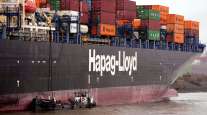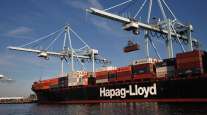Hapag-Lloyd, UASC in Merger Talks as Cargo-Price Crisis Lingers

Hapag-Lloyd is in talks with United Arab Shipping Co. on a possible combination of their container businesses, potentially setting up the German company’s second merger in two years as the maritime-freight industry grapples with a drop in prices.
Hapag-Lloyd would account for 72% of the combined entity’s value and UASC for 28%, the Hamburg-based company said April 21 in a statement. The carriers haven’t reached a binding agreement and may not complete a deal, it said. Hapag-Lloyd’s stock jumped to a three-month high in the biggest gain since the company’s initial public offering in November.
The joint company would rank fifth in an industry dominated by Danish shipping giant A.P. Moeller-Maersk A/S. Hapag-Lloyd now holds sixth place following its 2014 merger with the container business of Chilean rival Cia. Sud Americana de Vapores SA amid a wave of deals in response to losses stemming from plunging prices.
A merger would give Hapag-Lloyd immediate access to some of the largest container ships available as UASC, which has its headquarters in Dubai, operates six vessels with a capacity of 18,800 standard 20-foot containers, or TEU, a size the German carrier lacks and which is key to operating on Asia-Europe trade routes.
“Hapag-Lloyd so far shied away from ordering the biggest vessels though stakeholder Kuehne has pushed publicly in that direction,” Oliver Drebing, an analyst at Hamburg-based Alsterresearch, said in an e-mail. “If the merger works out, Hapag-Lloyd would no longer have to make the decision to order bigger ships.”
Hapag-Lloyd, which counts billionaire Klaus-Michael Kuehne as one of its biggest owners, surged as much as 16% to 19 euros as of 3:46 p.m. in Frankfurt, the highest intraday price since Jan. 14. That pared the stock’s decline since its IPO to 5%, for a market value of 2.24 billion euros ($2.54 billion). UASC gained 1% to 1.04 Egyptian pounds at the close in Cairo, valuing the company at 208 million pounds ($23.4 million).
International trade has yet to recover from the global recession eight years ago, prompting container carriers to merge or form alliances to survive. CMA CGM SA’s takeover of Singapore’s Neptune Orient Lines Ltd. and the combination of China Cosco Holdings Co. and China Shipping Container Lines, both announced in December, have cemented CMA’s position as No. 3 worldwide and pushed Cosco into fourth place.
“A merger would be a positive step for Hapag-Lloyd, as size matters in that highly competitive industry,” Thomas Wybierek, a shipping analyst at NordLB, said by e-mail before the German carrier officially announced the talks. “Hapag-Lloyd’s experience from the CSAV merger should create positive tailwinds for the next combination, even though the Chilean transaction was relatively recent and not all synergies have been finalized.”
Shareholder Kuehne, who holds about one-fifth of Hapag-Lloyd shares, has repeatedly said the German carrier needs to grow further through acquisitions or mergers to stay competitive. Chief Executive Officer Rolf Habben-Jansen said on March 23 that the company may pursue further combinations if opportunities arise.




